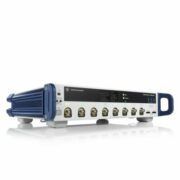Flash memory has supplanted other memory technologies in almost all market segments. Its success can be attributed to cost reduction through structure minimization, more information saved per cell thanks to various voltage levels (MLC and TLC flash memory), and new software features.
In terms of structure minimization, a physical limit has now been reached with today’s nm structures: The frequency of errors when reading out data is increasing, while there has been a decrease in endurance and data retention of flash memory at the same time. The solution: 3D NAND.
It is difficult to imagine a 3D NAND flash memory as a stacked, planar (2D) NAND grid. There are currently two 3D NAND flash technologies on the market:
IM Flash (an Intel, Micron venture) uses a floating gate to save the electrons, i.e. the same principle used in planar NAND flash.
The floating gate saves the charges on an electrically isolated gate between the channel and the control gate. Previously presented 3D NAND flash memories with a floating gate also use TLC and MLC storage technologies, which are already well-known from planar memories. Better endurance values are achieved here however.
All other manufacturers use charge trapping memory. Here the charges are stored at trapping centers. The trapping centers consist of a silicon nitride layer that is separated from the channel via a thin tunnel oxide layer.
The question of which memory is best suited to industrial application will only be answered once 3D NAND flash memory products hit the market. What will play a role in any case is the Write Amplification Factor (WAF).
What is the WAF? It indicates the ratio between the file size to be written and the data volume actually written to the memory. Here this also depends on the internal block size of the flash memory chip. Planar memory chips are produced with blocks of between 4MB and 8MB. IM Flash specifies 16MB for its 32-layer series for MLC products and 28MB for TLC products. Combined with an application that frequently writes small file sizes, this would result in unnecessary wear and thus in premature memory failure. In this specific application, the following applies: The bigger the individual blocks, the worse the WAF is. A DRAM cache might, for example, be the remedy here.
This means: 3D NAND flash memory is not likely to fully replace 2D variants any time soon, especially since products with the adequate temperature resistance – often required within industry – have not yet been developed.
In addition, 3D NAND flash memory from IM Flash is only available with 32-layers from a capacity of 32GB (MLC) or 48GB (TLC). However, many industry applications do not need such high capacities. This makes the switch to 3D NAND still too expensive.
Conclusion: It would be wrong to simply view 3D NAND flash memories as the successor to planar NAND flash memories. To judge whether 2D or 3D NAND flash memory is better requires closer analysis of the individual application and memory.
A new type of memory: 3D XPoint from IM Flash
In addition to the “normal” 3D NAND, IM Flash have also developed 3D XPoint. Here the memory cells are placed on the intersections of the 3D grid – hence the name 3D XPoint (crosspoint). Advantages of this memory architecture:
- Memory cells can be addressed individually.
- This means faster reading and writing processes at higher capacities.
- Storage densities eight to ten times higher than with DRAM are possible and at lower costs.
The difference compared with 2D NAND flash memories – alongside the three-dimensional memory structure – is that 3D XPoint memories do not use transistors.
Advantages of DRAM and flash in a memory
What’s revolutionary about 3D XPoint: Due to its values, it cannot be classed as flash memory or as DRAM in the strict sense.
While DRAM saves and reads data at very high speeds, it cannot retain information when the voltage is switched off.
A flash memory meanwhile can retain data without voltage being applied, but can only process it very slowly.
3D XPoint from IM Flash combines the advantages of DRAM and Flash memories: Information is processed quickly and retained without voltage being applied.
It even beats the previous market leader, the planar SLC NAND flash memory, for endurance. Another plus: The PCIe 3.0 x2 interface with NVMe protocol of the 3D XPoint memory allows rapid access times. Packaged in an M.2 form factor with the name “Optane Memory”, it can be used as a flash solution that can also assume the tasks of the main memory. This application results in a system that adapts to the needs of the user.
The intelligent software integrated into Intel Optane memory automatically learns typical patterns of computer use. This way the urgently required data is retrieved directly from the M.2 module. The system can thus accelerate frequently occurring tasks and optimize computer use individually.
The high costs per GB are a fly in the ointment however: 3D XPoint is approximately half the price of DRAM memory, but five times as expensive as a MLC NAND flash memory. In addition, there is no high temperature resistance associated with the Intel Optane memory and the 7th generation Intel Core processor is a further requirement.
Intel Optane Memory is currently available in 16GB and 32GB. Further capacities and form factors are expected in the future.
Get more information on this topic on our supplier pages of Intel and Transcend.
Find components at www.rutronik24.com.










